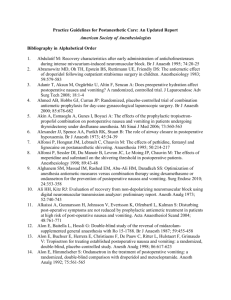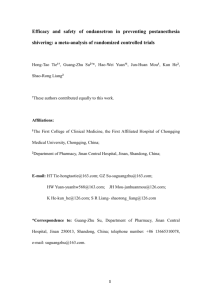Pediatric Airway Management and Pediatric Head And Neck
advertisement
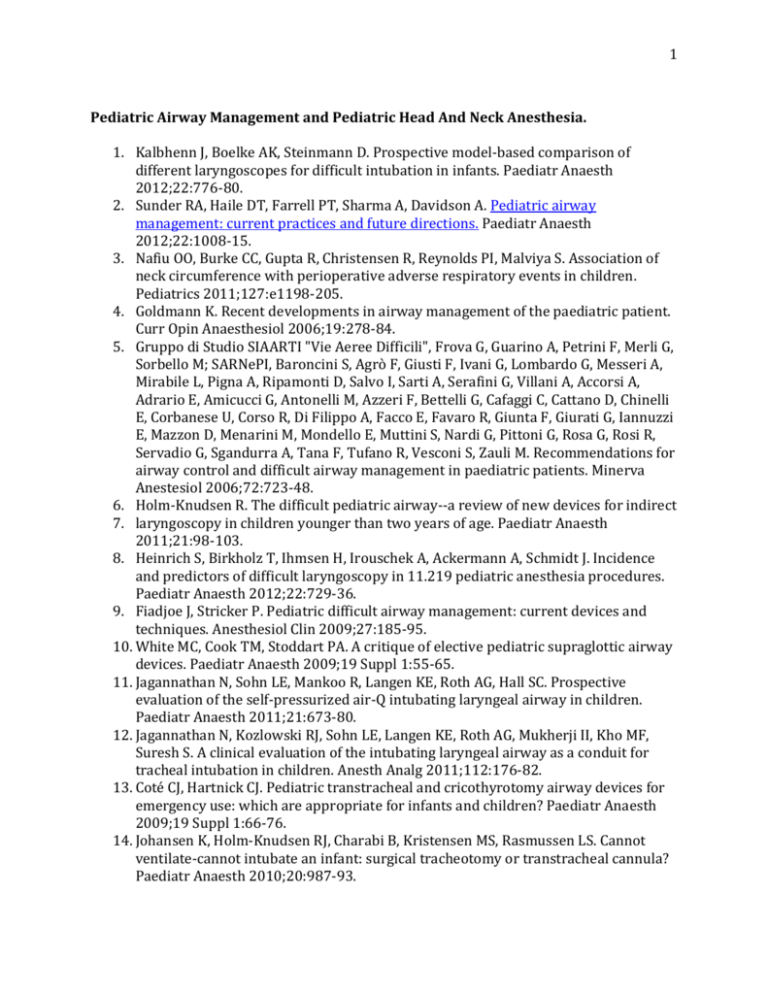
1 Pediatric Airway Management and Pediatric Head And Neck Anesthesia. 1. Kalbhenn J, Boelke AK, Steinmann D. Prospective model-based comparison of different laryngoscopes for difficult intubation in infants. Paediatr Anaesth 2012;22:776-80. 2. Sunder RA, Haile DT, Farrell PT, Sharma A, Davidson A. Pediatric airway management: current practices and future directions. Paediatr Anaesth 2012;22:1008-15. 3. Nafiu OO, Burke CC, Gupta R, Christensen R, Reynolds PI, Malviya S. Association of neck circumference with perioperative adverse respiratory events in children. Pediatrics 2011;127:e1198-205. 4. Goldmann K. Recent developments in airway management of the paediatric patient. Curr Opin Anaesthesiol 2006;19:278-84. 5. Gruppo di Studio SIAARTI "Vie Aeree Difficili", Frova G, Guarino A, Petrini F, Merli G, Sorbello M; SARNePI, Baroncini S, Agrò F, Giusti F, Ivani G, Lombardo G, Messeri A, Mirabile L, Pigna A, Ripamonti D, Salvo I, Sarti A, Serafini G, Villani A, Accorsi A, Adrario E, Amicucci G, Antonelli M, Azzeri F, Bettelli G, Cafaggi C, Cattano D, Chinelli E, Corbanese U, Corso R, Di Filippo A, Facco E, Favaro R, Giunta F, Giurati G, Iannuzzi E, Mazzon D, Menarini M, Mondello E, Muttini S, Nardi G, Pittoni G, Rosa G, Rosi R, Servadio G, Sgandurra A, Tana F, Tufano R, Vesconi S, Zauli M. Recommendations for airway control and difficult airway management in paediatric patients. Minerva Anestesiol 2006;72:723-48. 6. Holm-Knudsen R. The difficult pediatric airway--a review of new devices for indirect 7. laryngoscopy in children younger than two years of age. Paediatr Anaesth 2011;21:98-103. 8. Heinrich S, Birkholz T, Ihmsen H, Irouschek A, Ackermann A, Schmidt J. Incidence and predictors of difficult laryngoscopy in 11.219 pediatric anesthesia procedures. Paediatr Anaesth 2012;22:729-36. 9. Fiadjoe J, Stricker P. Pediatric difficult airway management: current devices and techniques. Anesthesiol Clin 2009;27:185-95. 10. White MC, Cook TM, Stoddart PA. A critique of elective pediatric supraglottic airway devices. Paediatr Anaesth 2009;19 Suppl 1:55-65. 11. Jagannathan N, Sohn LE, Mankoo R, Langen KE, Roth AG, Hall SC. Prospective evaluation of the self-pressurized air-Q intubating laryngeal airway in children. Paediatr Anaesth 2011;21:673-80. 12. Jagannathan N, Kozlowski RJ, Sohn LE, Langen KE, Roth AG, Mukherji II, Kho MF, Suresh S. A clinical evaluation of the intubating laryngeal airway as a conduit for tracheal intubation in children. Anesth Analg 2011;112:176-82. 13. Coté CJ, Hartnick CJ. Pediatric transtracheal and cricothyrotomy airway devices for emergency use: which are appropriate for infants and children? Paediatr Anaesth 2009;19 Suppl 1:66-76. 14. Johansen K, Holm-Knudsen RJ, Charabi B, Kristensen MS, Rasmussen LS. Cannot ventilate-cannot intubate an infant: surgical tracheotomy or transtracheal cannula? Paediatr Anaesth 2010;20:987-93. 2 15. Brambrink AM, Braun U. Airway management in infants and children. Best Pract Res Clin Anaesthesiol 2005;19:675-97. 16. Fayoux P, Marciniak B, Engelhardt T. Airway exchange catheters use in the airway management of neonates and infants undergoing surgical treatment of laryngeal stenosis. Pediatr Crit Care Med 2009;10:558-61. 17. Mausser G, Friedrich G, Schwarz G. Airway management and anesthesia in neonates, infants and children during endolaryngotracheal surgery. Paediatr Anaesth 2007;17:942-7. 18. Best C. Anesthesia for laser surgery of the airway in children. Paediatr Anaesth 2009;19 Suppl 1:155-65. 19. Benjamin B. Anesthesia for pediatric airway endoscopy. Otolaryngol Clin North Am 2000;33:29-47. 20. Kurth CD, LeBard SE. Association of postoperative apnea, airway obstruction, and hypoxemia in former premature infants. Anesthesiology 1991;75:22-6. 21. Hoeve LJ, Rombout J. Pediatric laryngobronchoscopy. 1332 procedures stored in a data base. Int J Pediatr Otorhinolaryngol 1992;24:73-82. 22. Yellon RF. Prevention and management of complications of airway surgery in children. Paediatr Anaesth 2004;14:107-11. 23. Shukry M, Kennedy K. Dexmedetomidine as a total intravenous anesthetic in infants. Pediatr Anesth 2007;17:581-3. 24. Quintal MC, Cunningham MJ, Ferrari LR. Tubeless spontaneous respiration technique for pediatric microlaryngeal surgery. Arch Otolaryngol Head Neck Surg 1997;123:209-14. 25. Malherbe S, Whyte S, Singh P, Amari E, King A, Ansermino JM. Total intravenous anesthesia and spontaneous respiration for airway endoscopy in children--a prospective evaluation. Paediatr Anaesth 2010;20:434-8. 26. Collins CE. Anesthesia for pediatric airway surgery: recommendations and review from a pediatric referral center. Anesthesiol Clin 2010;28:505-17. 27. Brooks P, Ree R, Rosen D, Ansermino M. Canadian pediatric anesthesiologists prefer inhalational anesthesia to manage difficult airways. Can J Anaesth 2005;52:285-90. 28. Chundamala J, Wright JG, Kemp SM. An evidence-based review of parental presence during anesthesia induction and parent/child anxiety. Can J Anaesth 2009;56:57-70. 29. Bandla P, Brooks LJ, Trimarchi T, Helfaer M. Obstructive sleep apnea syndrome in children. Anesthesiol Clin North America 2005;23:535-49. 30. Tait AR, Voepel-Lewis T, Burke C, Kostrzewa A, Lewis I. Incidence and risk factors for perioperative adverse respiratory events in children who are obese. Anesthesiology 2008;108:375-80. 31. Costa DJ, Mitchell R. Adenotonsillectomy for obstructive sleep apnea in obese children: a meta-analysis. Otolaryngol Head Neck Surg 2009;140:455-60. 32. Grainger J, Saravanappa N. Local anaesthetic for post-tonsillectomy pain: a systematic review and meta-analysis. Clin Otolaryngol 2008;33:411-9. 33. Mandel JE. Laryngeal mask airways in ear, nose, and throat procedures. Anesthesiol Clin 2010;28:469-83. 34. Megerian CA, Reily J, O'Connell FM, Heard SO. Outpatient tympanomastoidectomy: factors affecting hospital admission. Arch Otolaryngol Head Neck Surg 2000;126:1345-8. 3 35. Motoyama EK, Glazener GH. Hypoxemia after general anesthesia in children. Anesth Analg 1986;65:267-72. 36. Greenland KB, Edwards MJ, Hutton NJ, Challis VJ, Irwin MG, Sleigh JW. Changes in airway configuration with different head and neck positions using magnetic resonance imaging of normal airways: a new concept with possible clinical applications. Br J Anaesth 2010;105:683-90. 37. Lerman J, Heard C, Steward DJ. Neonatal tracheal intubation: an imbroglio unresolved. Paediatr Anesth 2010;20:585-90. 38. Bo L, Wang B, Shu SY. Anesthesia management in pediatric patients with laryngeal papillomatosis undergoing suspension laryngoscopic surgery and a review of the literature. Int J Pediatr Otorhinolaryngol 2011;75:1442-5. 39. Grasl MC, Donner A, Schragl E, Aloy A. Tubeless laryngotracheal surgery in infants and children via jet ventilation laryngoscope. Laryngoscope 1997;107:277-81. 40. Ihra G, Hieber C, Adel S, Kashanipour A, Aloy A. Tubeless combined high-frequency jet ventilation for laryngotracheal laser surgery in paediatric anaesthesia. Acta Anaesthesiol Scand 2000;44:475-9. 41. Mani V, Morton NS. Overview of total intravenous anesthesia in children. Paediatr Anaesth 2010;20:211-22. 42. Ma H, Lovich MA, Peterfreund RA. Quantitative analysis of continuous intravenous infusions in pediatric anesthesia: safety implications of dead volume, flow rates, and fluid delivery. Paediatr Anaesth 2011;21:78-86. 43. Yuen VM. Dexmedetomidine: perioperative applications in children. Paediatr Anaesth 2010;20:256-64. 44. Quezado ZM, Groblewski JC, Gelfand HJ, Shah RK. Dexmedetomidine and proprofol in complex microlaryngeal surgery in infants. Int J Pediatr Otorhinolaryngol 2009;73:1311-2. 45. Seybold JL, Ramamurthi RJ, Hammer GB. The use of dexmedetomidine during laryngoscopy, bronchoscopy, and tracheal extubation following tracheal reconstruction. Paediatr Anaesth 2007;17:1212-14. 46. Mahmoud M, Radhakrishman R, Gunter J, Sadhasivam S, Schapiro A, McAuliffe J, Kurth D, Wang Y, Nick TG, Donnelly LF. Effect of increasing depth of dexmedetomidine anesthesia on upper airway morphology in children. Paediatr Anaesth 2010;20:506-15. 47. Lerman J, Jöhr M. Inhalational anesthesia vs total intravenous anesthesia (TIVA) for pediatric anesthesia. Paediatr Anaesth 2009;19:521-34. 48. Munoz HR, Cortinez LI, Ibacache ME, Altermatt FR. Remifentanil requirements during during propofol administration to block the somatic responses to skin incision in children and adults. Anesth Analg 2007;104:77-80. 49. Verghese ST, Hannallah RS. Pediatric otolaryngologic emergencies. Anesthesiol Clin North America 2001;19:237-56. 50. Lei W, Wen W, Su Z, Chai L, Feng X, Liu K, Jiang A, Zhu X. Comparison of intravenous general anaesthesia vs endotracheal intubation in the surgical management of juvenile onset recurrent respiratory papillomatosis. Acta Otolaryngol 2010;130:281-5. 4 51. Pasquale K, Wiatrak B, Woolley A, Lewis L. Microdebrider versus CO2 laser removal of recurrent respiratory papillomas: a prospective analysis. Laryngoscope 2003;113:139-43. 52. Friedman EM. Tracheobronchial foreign bodies. Otolaryngol Clin North Am 2000;33:179-85. 53. Fidkowski CW, Zheng H, Firth PG. The anesthetic considerations of tracheobronchial foreign bodies in children: a literature review of 12,979 cases. Anesth Analg 2010;111:1016-25. 54. Farrell PT. Rigid bronchoscopy for foreign body removal: anaesthesia and ventilation. Paediatr Anaesth 2004;14:84-9. 55. Tomaske M, Gerber AC, Weiss M. Anesthesia and periinterventional morbidity of rigid bronchoscopy for tracheobronchial foreign body diagnosis and removal. Paediatr Anaesth 2006;16:123-9. 56. Blazer S, Naveh Y, Friedman A. Foreign body in the airway. A review of 200 cases. Am J Dis Child 1980;134:68-71. 57. Litman RS, Ponnuri J, Trogan I. Anesthesia for tracheal or bronchial foreign body removal in children: an analysis of ninety-four cases. Anesth Analg 2000;91:138991. 58. Kain ZN, O'Connor TZ, Berde CB. Management of tracheobronchial and esophageal foreign bodies in children: a survey study. J Clin Anesth 1994;6:28-32. 59. Pawar DK. Dislodgement of bronchial foreign body during retrieval in children. Paediatr Anaesth 2000;10:333-5. 60. Singh B, Kantu M, Har-El G, Lucente FE. Complications associated with 327 foreign bodies of the pharynx, larynx, and esophagus. Ann Otol Rhinol Laryngol 1997;106:301-4. Choanal Atresia. 1. Adil E, Huntley C, Choudhary A, Carr M. Congenital nasal obstruction: clinical and radiologic review. Eur J Pediatr 2012;171:641-50. 2. Bergeson PS, Shaw JC. Are infants really obligatory nasal breathers? Clin Pediatr (Phila) 2001;40:567-9. 3. Burrow TA, Saal HM, de Alarcon A, Martin LJ, Cotton RT, Hopkin RJ. Characterization of congenital anomalies in individuals with choanal atresia. Arch Otolaryngol Head Neck Surg 2009;135:543-7. 4. Kim H, Park JH, Chung H, Han DH, Kim DY, Lee CH, Rhee CS. Clinical features and surgical outcomes of congenital choanal atresia: factors influencing success from 20year review in an institute. Am J Otolaryngol 2012;33:308-12.
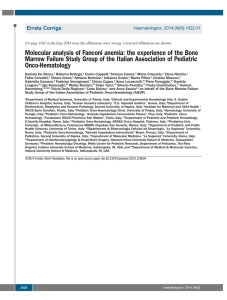
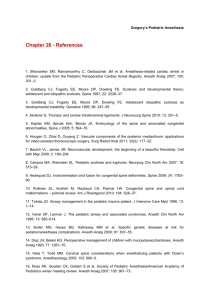
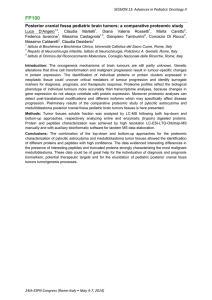
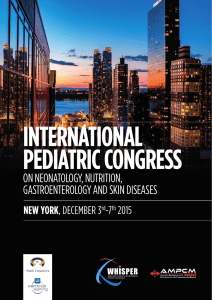
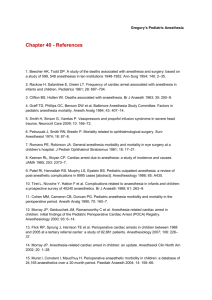
![REFERENCES OF THE EXCLUDED STUDIES [1] Talke P, Li J, Jain](http://s3.studylib.net/store/data/006720705_1-df24c1d93ae23a7e9c250fbed1b84ab3-300x300.png)
